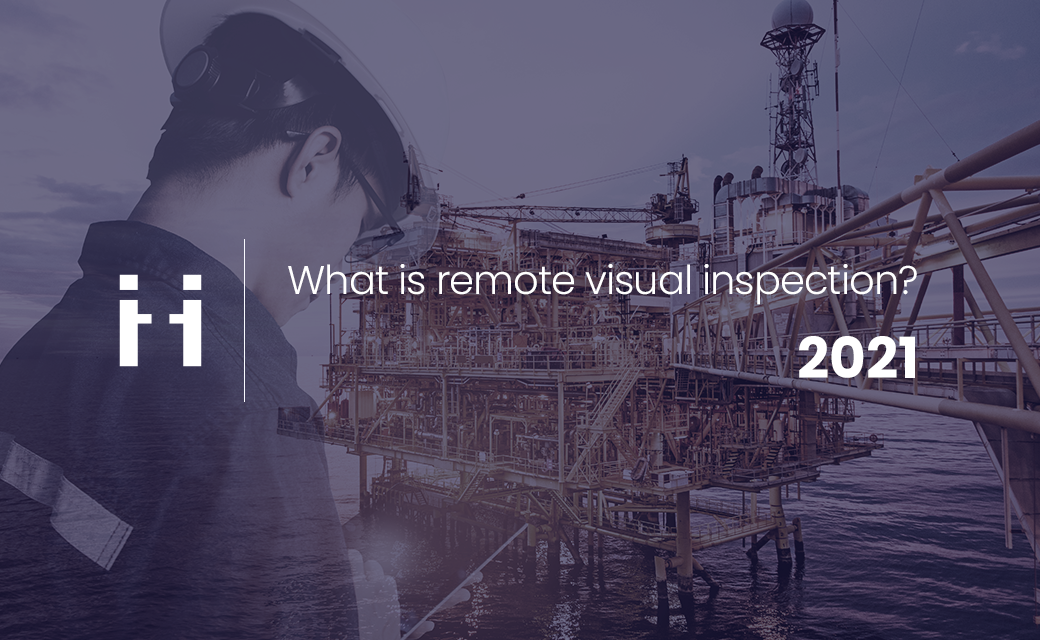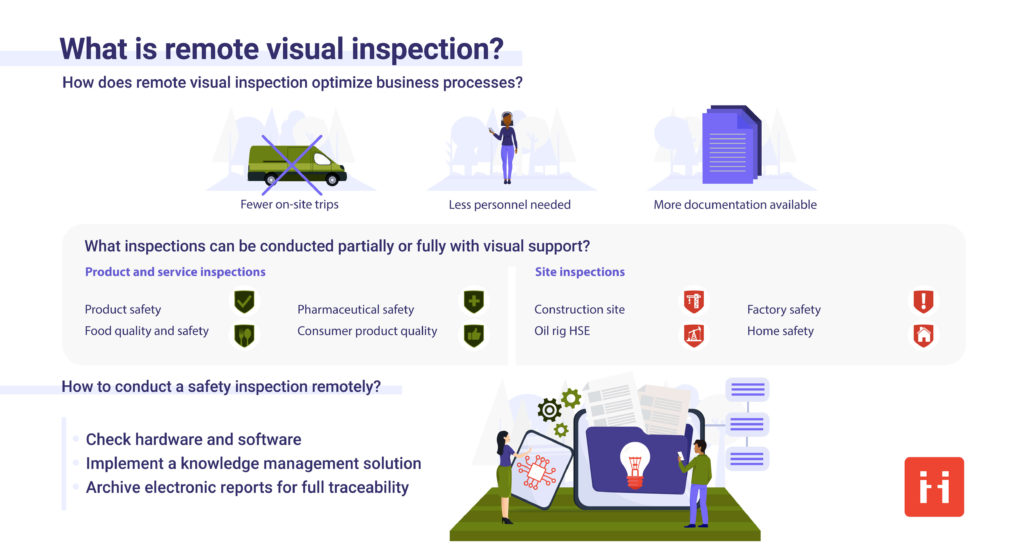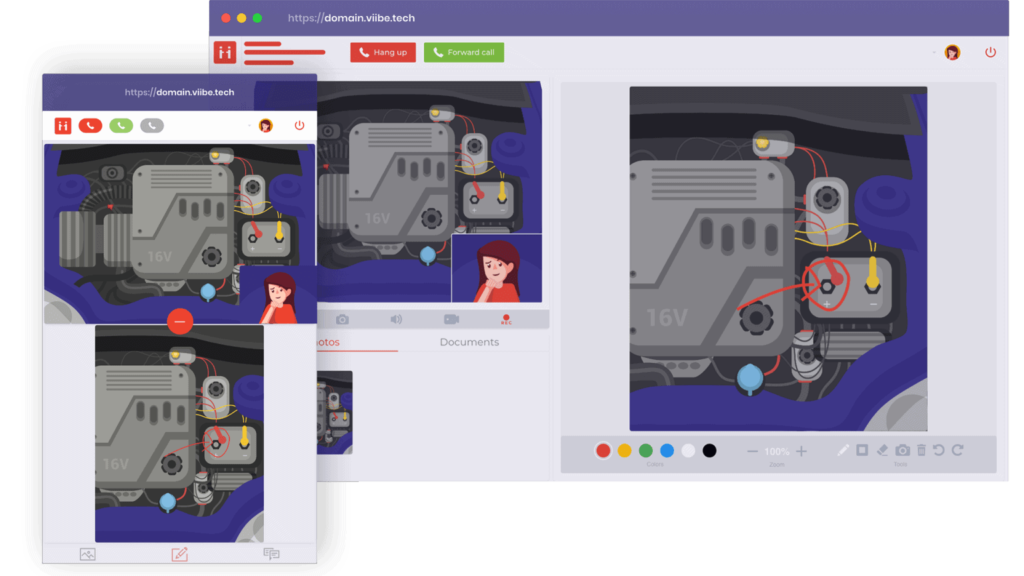
Share this article
Share this article
Remote visual inspection is any inspection conducted remotely by a technical expert, whether using specialized equipment like boreoscopes, or video conferencing or inspection software. Industries from retail to construction and beyond have adopted this technology. In many cases, remote visual inspection can replace conventional inspections outright, leading to huge savings. This article will explain the benefits, different use cases, and how to implement this technology.
Successful virtual inspection removes the need to send inspectors on-site in person. This saves your company time, money and reduces your carbon footprint. For one company, dispatching an expert to an oil rig is a 160 mile (257 km) trip. Remote video inspection technology allows inspectors to reliably conduct the inspection without having to make a trip. This is especially useful for Field service management purposes. These small savings in fuel and personnel costs add up over time. This technology is especially beneficial for inspections in a remote location where you would otherwise need a helicopter. Helicopters emit around 51.5 kg of CO2 per 100 kilometers per person, so avoiding these trips will reduce your company’s carbon emissions.
You need less personnel to conduct a remote inspection compared to a conventional one. Only one person and a smartphone are required on-site to complete the remote video inspection while it is live-streamed to the inspector. This saves you money on hiring costs and transportation expenses for multiple employees.
In their first year using ViiBE, Allianz Partners saved 5,000 tow truck trips. Thanks to ViiBE’s video chat, they were able to guide many motorists through repairs or advise them that they could continue driving until the closest mechanic. Additionally, ViiBE’s installation-free web app means you won’t have to worry about employing additional IT staff to implement remote video inspection.
The technology behind remote inspection will improve safety while ensuring a high-quality inspection. ViiBE’s video chat makes quality control easier by saving archived reports with pictures, documents, and notes to a centralized knowledge base. You can archive multiple calls under one ticket and use tags to label any specific search terms. If multiple trips are needed to complete the inspection, ViiBE can organize multiple calls under one ticket.

Since a wide variety of industries use remote inspection technology, their use cases can differ. These different inspections are all led by an expert who carries out the inspection by remote video chat.
Safety should always be your number one priority. A safety inspection focuses on the safety of your product or service by ensuring that it respects any safety protocols and standards. Remote inspection allows these safety inspections to continue and keep the supply chain flowing even when conventional inspections are not possible. Remote safety inspections are quickly becoming more common. The United States Food & Drug Administration (FDA) recently announced it will allow remote interactive evaluations of some pharmaceutical facilities.
Quality control inspection ensures that quality is standardized for your product or service according to internal and governmental norms. This protects your brand’s reputation and prevents future customer complaints. The quality control can be both a specific product inspection and also an overall process inspection. In many cases, remote visual inspection can supplant in-person inspections for quality control.

Site inspection verifies the quality and safety of a worksite. This applies to construction sites, factory machinery, oil rigs, and a whole host of other use cases. Since the pandemic, remote video inspection has become more commonplace. The inspector is guided through the site and is shown the components to inspect, just like they would be in person. ViiBE’s video call software allows the inspector to remotely use a laser pointer to guide the on-site personnel to manipulate equipment. For a more detailed look into remote video inspection in the construction industry, see the National Fire Protection Association’s 2018 guidelines.
For home buyers, an inspection is a crucial part of the home buying process. Before taking the keys to their new home, an inspector must verify that the house is safe to live in. They must check for safety hazards like mold and rotting beams and verify plumbing and other infrastructure quality. The inspector creates a report at the end of their inspection detailing their findings. If there are issues, the real estate agent advises how to proceed. Many home buyers have opted for a virtual inspection since the Covid-19 pandemic rendered it complicated to be in the home at the same time as the inspector.
A remote inspector must have the same qualifications as one on-site. The inspection process is essentially the same, except the inspector is viewing through a screen in real time. Remote safety inspections are a great alternative when it is not possible to travel on-site, but make sure that the inspector endorses the choice to perform the inspection remotely for your given situation. Here are a few ways to prepare for your remote inspection. This is not safety advice, only your inspector is certified in the appropriate health and safety regulations for your use case.
Make sure your audio video equipment is not damaged and is in working order. Test your connection to make sure the signal is strong enough for a video call. Conduct a test call before the actual test to verify everything is running smoothly.
Implementing knowledge management will improve your inspector’s access to past inspection data for random sampling. ViiBE allows you to use tags to trace any discrepancies found when conducting random samples.
Archiving inspection reports allows for full traceability of past inspections. ViiBE’s knowledge management tool makes it simple to organize many related documents, notes, and images. If you identify an issue as reoccurring, the knowledge management tool allows you to quickly inspect a wide swath of past inspection data at once. ViiBE’s tags make it easy to organize and keep track of issues.

Remote visual inspection has many advantages over traditional inspections. It saves you money while reducing your company’s impact on the environment. It saves time for your inspectors and reduces your overhead costs. ViiBE takes these advantages even further with its knowledge management and ticketing solutions that improve traceability. At first, it may seem daunting to switch to a new inspection model. ViiBE makes it easy to implement remote visual inspection no matter what your use case.
Free E-book available now!